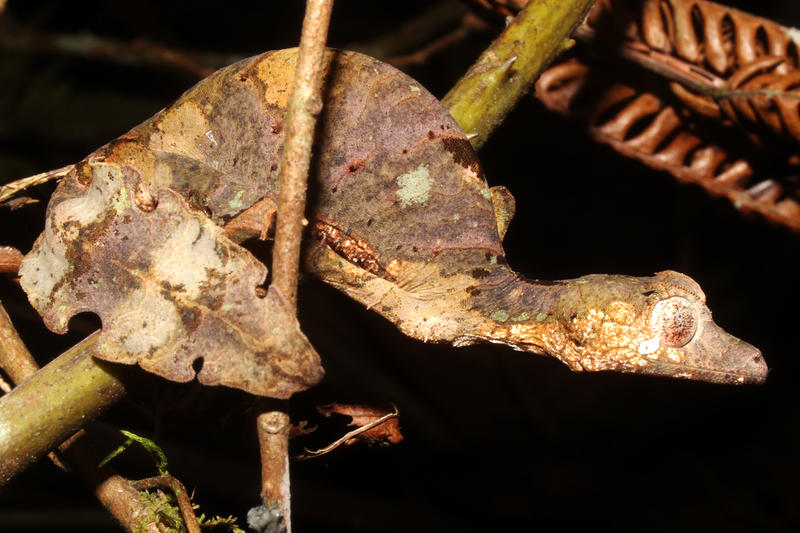Island reptiles face extinction before they are even studied
A new study has revealed that reptiles confined to islands are facing a double jeopardy. Despite being more likely to go extinct than mainland species, they remain largely ignored by researchers compared to their mainland counterparts.
Although islands make up less than 7% of the Earth’s surface, they harbour a disproportionate share of the planet’s biodiversity. Out of the roughly 12,000 known reptile species, around one-third are confined to islands - including iconic species such as the Galapagos tortoise and Komodo Dragon. These isolated ecosystems act as natural laboratories of evolution, where species adapt and diversify in unique environments.

Uroplatus phantasticus, restricted to Madagascar
Image: Ricardo Rocha
Yet the very isolation that fosters this uniqueness also makes island reptiles more vulnerable. A new global assessment found that 30% of island dwelling reptiles are threatened with extinction (compared with 12.1% of reptiles overall). Despite this, only 6.7% of reptile-focused research publications since 1960 have studied them.
Dr Ricardo Rocha, senior author of the study, said:
“Reptiles are keystone species for island ecosystems. For example, on Madeira Island – my birthplace – wall lizards are everywhere, chasing insects, pollinating plants, and eating fruits. If island reptiles are allowed disappear, this would have huge impacts on many other species.”
Globally, reptiles are one of the most vulnerable vertebrate groups to human disturbance, with populations threatened by agricultural expansion, logging, pollution and invasive species.
“Many island reptiles evolved in the absence of mammalian predators, so they haven’t developed strong defensive behaviours,” added Dr Rocha. “This makes them easy targets for predators such as free-ranging cats, which are a leading cause of extinctions on islands. On Madeira Island, our research found that a single cat can eat more than 90 lizards in just one year - a striking example of how introduced predators can upset fragile island ecosystems.”
The researchers compared the volume of research published 1960-2021 between island and mainland reptiles and examined how factors such as species size, distribution, geography, and socioeconomic context influence research focus. They found that larger and more widespread species receive most attention, while smaller, recently described and high-altitude island species remain largely unstudied.

Tarentola boettgeri, restricted to the Selvagens and Canary Islands
Image: Ricardo Rocha
“Many of the world’s most distinctive reptiles - those that evolved in isolation on islands - are the least known,” said PhD candidate Sara Nunes from the University of Porto. “This knowledge gap is especially concerning because these species often have small ranges and face intense human pressures.”
According to the study’s authors, reasons for the disparity may include the remoteness and inaccessibility of many islands, a global bias towards charismatic or medically significant reptiles, and a mismatch in research funding priorities. In wealthier island nations, investment may focus more on tourism infrastructure than biodiversity science.
To address this imbalance, the researchers propose a series of actions:
- Prioritise targeted research on island-dwelling reptiles—especially those at high risk of extinction and with little or no existing data;
- Foster equitable collaborations between national institutions and island communities to build local capacity;
- Incorporate knowledge from beyond academic literature to include reports from NGOs, government agencies, and local institutions;
- Translate and integrate non-English language studies to capture a fuller picture of global reptile research.
Examples of the ecological and evolutionary importance of island reptiles abound - from the spectacular radiation of Anolis lizards in the Caribbean to the diversity of giant tortoises in the Galápagos. Madagascar alone, covering less than 0.4% of Earth’s land area, is home to over 450 reptile species - 3.8% of all known reptiles - and a quarter of all IUCN-listed threatened reptile species.
The Indo-Malayan region emerged as a critical hotspot of island reptile diversity, yet it remains one of the most poorly studied. The researchers identified several high-priority species, many of them endemic to a single island-for which no research has yet been conducted.
“As the biodiversity crisis deepens, understanding and protecting island reptiles has never been more urgent,” added Dr Rocha. “Focusing scientific and conservation efforts where they are most needed – eg on islands and their unique reptile species – is essential to prevent irreversible losses. Imagine visiting Komodo Island and not seeing its dragons. It just wouldn’t be the same, would it?”

Deforestation in Madagascar. Reptiles are one of the most vulnerable vertebrate groups to human disturbance, with populations threatened by agricultural expansion, logging, pollution and invasive species.
Image: Ricardo Rocha
The study also involved researchers from the University of Porto; Leibniz-Institute of Freshwater Ecology and Inland Fisheries (IGB) Berlin; Global Change and Sustainability Institute, Lisbon; Universidade de Lisboa; University of Helsinki.
To read more about this research, published in Conservation Science and Practice, visit: https://doi.org/10.1111/csp2.70184

